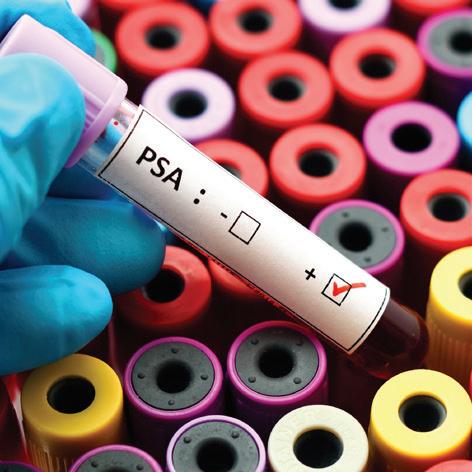
5 minute read
WHAT EVERY MAN SHOULD KNOW ABOUT HIS
THIS SMALL BUT IMPORTANT GLAND CHANGES OVER TIME. HERE’S HOW TO KEEP IT HEALTHY.
It’s about the size of a walnut,
RWJBarnabas Health and just below the bladder and RWJUH Rahway, together with surrounding the urethra. Rutgers Cancer Institute of New Most men don’t even realize Jersey—the state’s only NCI-Designated it’s there during their first few Comprehensive Cancer Center—provide decades of life. But the prostate close-to-home access to the latest gland becomes more important treatment options. For more information, to men as they age, and it could call 844.CANCERNJ cause major trouble if it’s left or visit unchecked. www.rwjbh.org/beatcancer. “Men often have few to no symptoms in the early stages of a prostate issue, even with a serious disease
WHAT like prostate cancer,” says Brett Opell, MD, a urologist with Robert Wood Johnson University Hospital (RWJUH)
EVERY MAN Rahway. “That’s why routine prostate screening is so important.” SHOULD KNOW What does the prostate do? Located at the base of the bladder, the prostate gland produces fluid that nourishes and protects a man’s sperm.
ABOUT HIS Also, the muscles inside the prostate gland function as a valve. Those muscles close the bladder and keep urine in.
PROSTATE
How can I keep my prostate gland healthy?
Being in overall good health will help your prostate gland stay in tip-top shape. Follow a heart-healthy diet. “Broccoli, brussels sprouts and cauliflower have proven anticancer properties,” Dr. Opell says. “A diet with a variety of vegetables is best.” Limit the amount of foods associated with a high risk of prostate cancer, such as red meat and saturated fats. Also, exercise regularly to improve your circulation.
How can I tell if my prostate isn’t healthy?
“Symptoms of prostate issues include having a weak urine stream, urinary frequency, burning on urination, pelvic pressure sensation, waking up more than two times a night to urinate, feeling the need to strain or push when urinating, or having blood in the urine,” Dr. Opell says.
What changes to the prostate occur over time?
It grows bigger, which is a natural part of aging. “Most men’s prostate glands grow between 1 to 3 percent per year during their adulthood, and inflammation may accelerate this growth,” Dr. Opell says.
However, about 50 percent of men at age 50 will develop an enlarged prostate (also called benign prostatic hyperplasia, or BPH), which can cause discomfort and difficulty with urinating. By age 80, up to 90 percent of men have BPH.
BPH is the most common prostate-related health concern. Other prostate problems include prostatitis, an inflammation of the prostate most often caused by infection, and prostate cancer.

How is BPH treated?
Treatment may include behavioral changes, such as minimizing caffeine and evening fluids, or medication to relax muscles in and around the prostate and make urination easier. If these measures aren’t effective, next steps may include:
• Transurethral resection of the
prostate (TURP). This procedure trims away excess tissue blocking urine flow. • Simple prostatectomy. This is the removal of only the inner part of the prostate, often done with minimally invasive robotic surgery. • UroLift. In this brief, minimally invasive procedure, tiny implants lift the enlarged prostate out of the way to help improve urine stream and reduce urination frequency. • Rezūm. Done under mild anesthesia, this water vapor therapy infuses steam into the urethra, which relaxes the gland and opens the urethra. Like UroLift, it is brief and can be done in the office.
When should men begin screening for prostate cancer?
Most men should start talking with a doctor about routine prostate cancer screening between the ages of 40 and 45. “A shared decision-making process is used to determine the appropriate time and frequency of screening, depending on personal risk factors,” says Dr. Opell. “If after initial evaluation men fall into a low-risk category, they may safely resume screening around age 50 to 55. Black men and men with a family history of prostate, breast or ovarian cancer are encouraged to start the discussion at age 40.”
Screening includes two tests—a physical exam of the prostate, also called a digital rectal exam, and a blood test that checks for the level of prostatespecific antigen (PSA), a protein made by cells in the prostate gland. Your doctor will determine follow-up screenings based on the results.
What do PSA tests reveal?
Doctors evaluate two factors. One is PSA velocity, a measure of PSA levels over time. “If the velocity is more than 0.75 per year, this is considered significant and may indicate the need for a prostate biopsy to rule out cancer,” Dr. Opell says. The other is PSA density, which compares the PSA to the size or volume of the prostate.
If your PSA results indicate possible prostate cancer, your doctor will ask you to get a biopsy of the prostate, which will determine whether or not you have cancer.
Some newer blood tests, such as 4Kscore and other genetic and genomic tests, can also help assess the risk of aggressive prostate cancer after an abnormal PSA or digital rectal exam.
TREATMENTS FOR PROSTATE CANCER
After skin and lung cancers, prostate cancer is the most common cancer in men. One in eight men will be diagnosed with prostate cancer during his lifetime. “However, survival rates are high, especially when the cancer is caught early,” says Pawan Gundavaram, MD, a hematologist/oncologist at RWJUH Rahway. Because prostate cancer can be slow-growing, not every man will need to be treated right away. In many cases, “watchful waiting” may be advised. However, depending on the stage of the cancer, treatments may include: • Radiation therapy, utilizing a linear accelerator that delivers external beam radiation with precision, or brachytherapy, in which radioactive material is sealed in a seed and placed inside the body. • Cryotherapy, which uses extreme cold to freeze and kill prostate cancer cells. • Radical prostatectomy, which removes the entire prostate gland, sometimes with nearby tissue, such as lymph nodes. Surgeons may use the da Vinci Robotic
Surgical System, with tiny incisions and up to 10 times magnification.
• Androgen deprivation therapy and
chemotherapy may be used if there is high risk or advanced disease at presentation. • Newer treatments include immunotherapy and PARP (poly
adenosine diphosphate-ribose
polymerase) inhibitors, a drug that helps repair DNA damage in cells.
To find a urologist at RWJUH Rahway, call 888.724.7123 or visit www.rwjbh.org/rahway.










